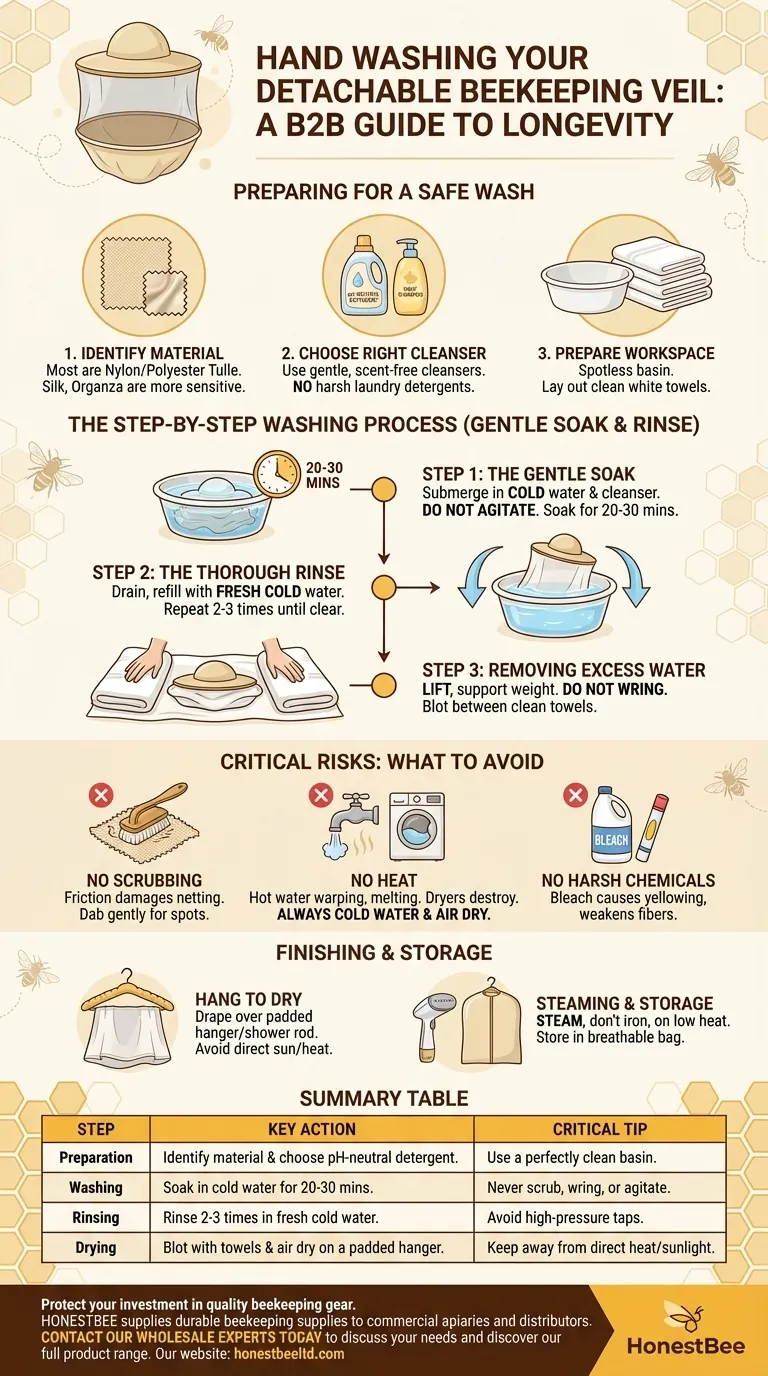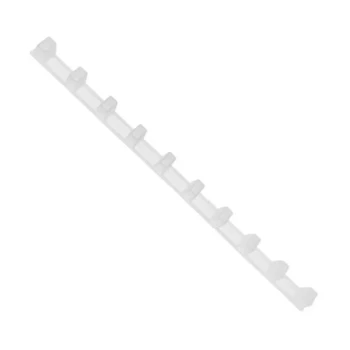To safely hand wash a detachable veil, you must use a gentle, soak-and-rinse method. Fill a clean basin with cold water and a small amount of a pH-neutral, delicate-fabric detergent. Submerge the veil, allow it to soak for about 30 minutes, and then rinse it thoroughly with cool, clean water before draping it over a padded hanger or clean shower rod to air dry.
The core principle of washing a veil is to avoid friction at all costs. The delicate netting is extremely susceptible to snags, tears, and stretching, so gentle soaking and rinsing—never scrubbing, wringing, or brushing—is the only safe method.

Preparing for a Safe Wash
Before the veil ever touches water, a few preparatory steps are critical to ensure a successful outcome. The goal is to set up a controlled environment that protects the delicate fabric.
Identify Your Veil's Material
Most modern veils are made from nylon or polyester tulle, which is relatively durable. However, some are made from silk tulle, organza, or chiffon. These natural fibers are more sensitive to temperature and require even greater care.
Choose the Right Cleanser
Standard laundry detergents are too harsh and can leave residue or cause yellowing. Opt for a pH-neutral detergent specifically made for delicates or even a few drops of clear, scent-free baby shampoo.
Prepare Your Workspace
Use a spotlessly clean sink or basin to prevent accidental staining. Remove any rings or bracelets that could snag the material. Lay out a clean, thick white towel next to your workspace for the drying prep stage.
The Step-by-Step Washing Process
Patience and a gentle hand are your most important tools. Work slowly and methodically.
Step 1: The Gentle Soak
Fill your basin with cold water and add your chosen cleanser, mixing it well. Gently submerge the entire veil, pressing it down until it is saturated. Do not agitate or swish it aggressively. Let it soak for 20-30 minutes.
Step 2: The Thorough Rinse
Drain the soapy water. Refill the basin with fresh, cold water and submerge the veil again to rinse. Repeat this process two or three times until no suds remain and the water is clear. Avoid rinsing directly under a powerful tap, as the pressure can stretch the fabric.
Step 3: Removing Excess Water
Lift the veil from the water, supporting its full weight to prevent stretching. Do not wring or twist it. Lay it flat on the thick white towel you prepared earlier. Place another white towel on top and gently press or blot to absorb the majority of the water.
Critical Risks and How to Avoid Them
Many common cleaning instincts can permanently damage a veil. Understanding what not to do is as important as knowing what to do.
The Danger of Abrasion: Why You Must Never Scrub
Some guides may suggest using a soft brush. This is dangerous advice. Any form of scrubbing, rubbing, or brushing—no matter how soft the bristles—creates friction that can easily catch and tear the delicate netting or dislodge beading and crystals. For stubborn spots, dabbing gently with a fingertip and cleanser is the only safe option.
The Risk of Heat: Avoid Hot Water and Dryers
Hot water can cause synthetic fibers like nylon to warp or even melt slightly, altering the texture of the veil. It can also cause shrinkage in natural fibers like silk. A machine dryer will destroy a veil through both heat and tumbling action. Only use cold water and always air dry.
The Problem with Harsh Chemicals
Never use bleach, stain sticks, or strong detergents. These products can cause irreversible yellowing on white or ivory fabrics and can weaken the fibers over time, making them brittle and prone to tearing.
Finishing and Storing Your Veil
Proper drying and storage will preserve the veil's shape and beauty.
Correctly Hang to Dry
Drape the damp veil over a clean, non-staining shower rod or a padded hanger. Ensure it is not folded in a way that creates a hard crease. Hang it away from direct sunlight or heat sources. It will typically dry within a few hours.
Releasing Wrinkles Safely
Never iron a veil directly. The heat is too concentrated and will melt the fabric. The safest way to remove wrinkles is to use a handheld steamer on a low-heat setting, keeping the nozzle at least six inches away from the fabric at all times.
Storing for the Future
Once completely dry, store the veil in a breathable garment bag or wrapped loosely in acid-free tissue paper inside a storage box. This protects it from dust, light, and humidity without trapping moisture.
If your focus is simply cleaning a sturdy, unembellished nylon veil: A gentle soak and rinse in the sink is a low-risk and effective method. If your veil has delicate lace, beading, or extensive embroidery: Prioritize spot cleaning any soiled areas and consider a very brief, gentle soak to refresh the rest of the fabric. If your veil is a silk heirloom or has significant sentimental value: The safest and most prudent choice is to consult a professional cleaner specializing in bridal wear preservation.
By treating the material with deliberate care, you can successfully clean your veil and preserve it for years to come.
Summary Table:
| Step | Key Action | Critical Tip |
|---|---|---|
| Preparation | Identify material & choose pH-neutral detergent. | Use a perfectly clean basin to prevent stains. |
| Washing | Soak in cold water for 20-30 minutes. | Never scrub, wring, or agitate the fabric. |
| Rinsing | Rinse 2-3 times in fresh cold water. | Avoid high-pressure taps to prevent stretching. |
| Drying | Blot with towels & air dry on a padded hanger. | Keep away from direct heat and sunlight. |
Protect your investment in quality beekeeping gear with the right care. Properly maintaining your detachable veil is essential for comfort and safety in the apiary. At HONESTBEE, we supply durable beekeeping supplies and equipment to commercial apiaries and distributors. Let us help you equip your operation with veils and protective gear built to last. Contact our wholesale experts today to discuss your needs and discover our full product range.
Visual Guide

Related Products
- Beekeeper Cowboy Hat and Veil for Beekeeping
- Heavy Duty Cowboy Beekeeper Hat with Visibility Veil Outdoor Professional Beekeeping Protective Gear
- Square Folding Bee Hat Veil with String for Beekeeping
- Long Langstroth Style Horizontal Top Bar Hive for Wholesale
- JZBZ Langstroth Queen Rearing Frame for Beekeeping
People Also Ask
- Why are a hat and veil considered the most important parts of beekeeping protective gear? Essential Protection for Your Face and Confidence
- What activities is the beekeeping hat suitable for? Beyond the Hive for Ultimate Outdoor Protection
- What features enhance the quality of the beekeeping veil? Choose the Right Protection for Your Apiary
- How does the design of the beekeeping hat ensure comfort during extended use? Maximize Comfort for Long Apiary Hours
- Why is head protection important for beekeepers? Essential Safety for Confident Hive Management



















